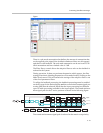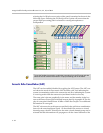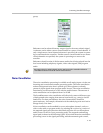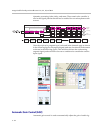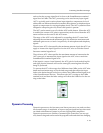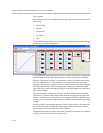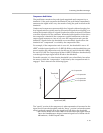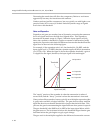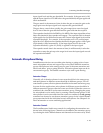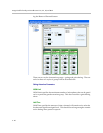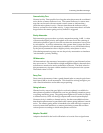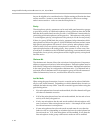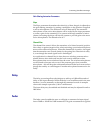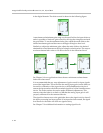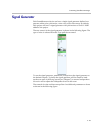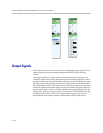
Customizing SoundStructure Designs
5 - 39
input signal level and the gate threshold. For example, if the gate ratio is 10:1
and the input signal level is 6 dB below the gate threshold, the gate applies 60
dB of attenuation.
The gate attack is the amount of time it takes the gate to ramp the gain to the
target gain once the input signal level surpasses the gate threshold.
The gate decay controls how quickly the gain ramps down once the signal
level is lower than the gate threshold and the gate hold time has expired.
The expander threshold is the RMS level in dBFS of the input signal that when
below this threshold, the expander will engage. The expander ratio is the mul-
tiplier applied to the difference between the current input signal level and the
expander threshold. For example, if the expander ratio is 2:1 and the input
signal level is 3 dB below the expander threshold, the gate applies -6 dB of gain
(equivalently 6 dB of attenuation). If the input signal level is above the
expander threshold, a gain of 1 (0 dB), is applied to the input signal.
The expander attack time is the amount of time (in milliseconds) it takes the
expander to ramp the gain up to the target level once the input signal exceeds
the expander threshold.
Automatic Microphone Mixing
SoundStructure devices can use either gain sharing or gating styles of auto-
matic microphone mixers and support up to sixty-three different automixer
groups. Microphones in the same group are part of the same automixer and
affect each others’ gain or gating behavior. Each microphone input can be in
one automixer group. The default automixer style used is gain-sharing.
Automixer Groups
Generally, all of the microphones in one room should be in the same group,
and microphones in different rooms should be in different groups. Even in
zoned audio systems, all microphones should be in the same automixer group.
In room division applications, microphones in different rooms should be in
different automixer groups when the rooms are divided. When the rooms are
combined, they should be in the same automixer group. Changing the group
for microphones can be easily done by creating virtual channel groups of the
microphones in each room and when the rooms are combined, the am_group
command can be used to set the new automixer group for the virtual channel
group associated with the individual room’s microphones. See Chapter 9 for
more information on room combining applications.
Automixer Controls
The SoundStructure Studio user controls for configuring the automixers are
shown in the following figure. Channels can be added to the automixer group
by selecting the Add Channels button and channels can be removed by select-



